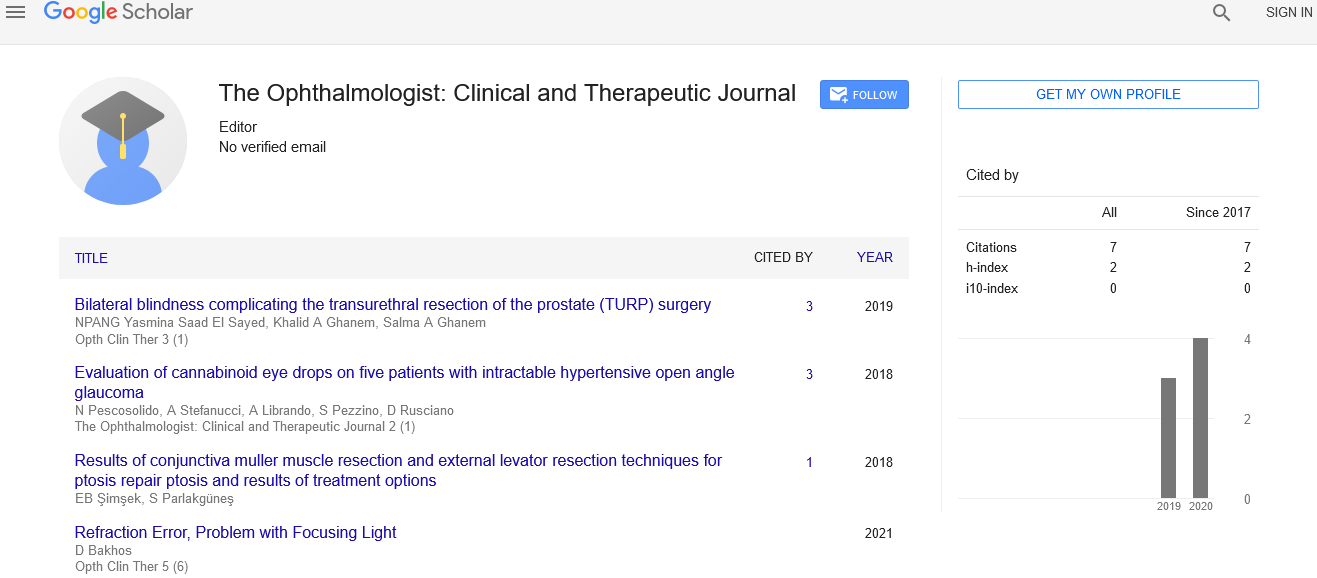Ocular pathology: Vital for identifying and improving retinoblastoma treatment
Received: 16-Oct-2023, Manuscript No. PULOCTJ-23-6804; Editor assigned: 18-Oct-2023, Pre QC No. PULOCTJ-23-6804 (PQ); Reviewed: 02-Nov-2023 QC No. PULOCTJ-23-6804; Revised: 17-Jan-2024, Manuscript No. PULOCTJ-23-6804 (R); Published: 24-Jan-2024
Citation: Jenny O. Ocular pathology: Vital for identifying and improving retinoblastoma treatment. Opth Clin Ther. 2024;8(1):1.
This open-access article is distributed under the terms of the Creative Commons Attribution Non-Commercial License (CC BY-NC) (http://creativecommons.org/licenses/by-nc/4.0/), which permits reuse, distribution and reproduction of the article, provided that the original work is properly cited and the reuse is restricted to noncommercial purposes. For commercial reuse, contact reprints@pulsus.com
Abstract
Retinoblastoma is a malignant tumor of the retina primarily affecting young children. Early diagnosis and appropriate treatment are essential for a favorable outcome. Ocular pathology plays a crucial role in identifying and understanding the characteristics of retinoblastoma, aiding in personalized treatment approaches. This research article explores the significance of ocular pathology in the diagnosis, prognosis, and improvement of treatment strategies for retinoblastoma.
Keywords
Retinoblastoma; Ocular pathology; Diagnosis; Treatment; Prognosis
Introduction
Retinoblastoma is a rare and aggressive form of eye cancer that predominantly affects children, typically below the age of five years. It originates from the retina and can manifest as a white or cloudy pupil, strabismus, or redness in the eye. The early diagnosis of retinoblastoma is crucial for a positive prognosis and successful treatment outcome. Ocular pathology, the study of eye diseases and disorders, is pivotal in understanding the nature of retinoblastoma, its progression, and in developing targeted treatment strategies.
Ocular pathology involves the examination and analysis of tissue samples from the eye affected by retinoblastoma. This examination helps in identifying the specific characteristics of the tumor, such as its size, location, extent of invasion, and cell type. Understanding these aspects is critical for devising an effective treatment plan tailored to the individual patient. The pathology report provides essential information to oncologists, guiding them in choosing the most appropriate therapeutic approach, including chemotherapy, radiation, or surgical interventions.
Description
To investigate the role of ocular pathology in improving retinoblastoma treatment, a comprehensive review of existing literature and studies related to retinoblastoma and ocular pathology was conducted. The research involved analyzing the diagnostic methods, treatment strategies, and outcomes associated with the incorporation of ocular pathology in the management of retinoblastoma.
The results of this study highlight that ocular pathology significantly contributes to the accurate diagnosis and prognosis of retinoblastoma. It helps in identifying the stage and severity of the tumor, aiding in the development of personalized treatment plans. Ocular pathology also plays a crucial role in assessing the response to treatment, monitoring disease progression, and detecting any signs of recurrence.
In addition to its diagnostic and prognostic value, ocular pathology is essential for advancing our understanding of retinoblastoma at a molecular level. Recent studies have focused on identifying genetic mutations and biomarkers associated with retinoblastoma, which can provide insights into tumor behavior and patient outcomes. For instance, mutations in the RB1 gene are well-established in retinoblastoma and can influence treatment decisions, particularly regarding the likelihood of metastasis and the need for aggressive therapy.
Furthermore, ocular pathology contributes to the development of innovative therapeutic strategies. Understanding the histological characteristics of retinoblastoma tumors can guide the use of targeted therapies that may enhance the effectiveness of conventional treatments. Ongoing research into the tumor microenvironment, including the role of immune cells and signaling pathways, is opening new avenues for immunotherapy and personalized medicine in retinoblastoma management.
Additionally, collaboration between ocular pathologists, pediatric oncologists, and geneticists is crucial for improving patient outcomes. Multidisciplinary teams can leverage their expertise to create comprehensive care plans that not only address the immediate needs of retinoblastoma patients but also focus on long-term surveillance and quality of life considerations.
The integration of advanced imaging techniques and molecular diagnostics with traditional pathology is also revolutionizing the field. Techniques such as whole-exome sequencing and next-generation sequencing allow for a more detailed understanding of tumor heterogeneity, which can inform treatment approaches and help predict responses to therapy.
Conclusion
Ocular pathology is indispensable in identifying and improving the treatment of retinoblastoma. Its role in accurately diagnosing the disease, understanding its characteristics, and guiding treatment decisions cannot be overstated. Through the integration of ocular pathology in the management of retinoblastoma, healthcare professionals can offer tailored and targeted treatment strategies, ultimately enhancing the outcomes and quality of life for children affected by this aggressive eye cancer. Continued research and advancements in ocular pathology will further refine our understanding of retinoblastoma and contribute to the ongoing improvement of treatment options and patient care.





